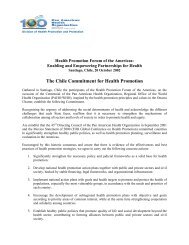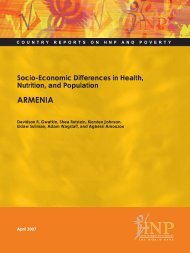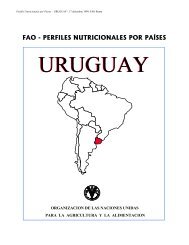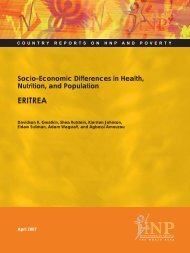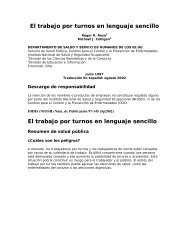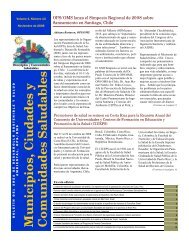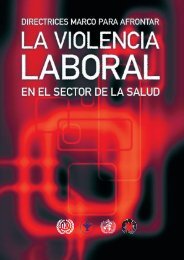Guidelines for drinking-water quality. Volume 1 - BVSDE
Guidelines for drinking-water quality. Volume 1 - BVSDE
Guidelines for drinking-water quality. Volume 1 - BVSDE
You also want an ePaper? Increase the reach of your titles
YUMPU automatically turns print PDFs into web optimized ePapers that Google loves.
of acquiring an infective dose cannot be predicted from their average concentration in <strong>water</strong>.<br />
• The likelihood of a successful challenge by a pathogen, resulting in infection, depends upon<br />
the invasiveness and virulence of the pathogen, as well as upon the immunity of the individual.<br />
• If infection is established, pathogens multiply in their host. Certain pathogenic bacteria are<br />
also able to multiply in food or beverages, thereby perpetuating or even increasing the<br />
chances of infection.<br />
• Unlike many chemical agents, the dose response of pathogens is not cumulative.<br />
Because of these properties there is no tolerable lower limit <strong>for</strong> pathogens, and <strong>water</strong> intended <strong>for</strong><br />
consumption, <strong>for</strong> preparing food and drink, or <strong>for</strong> personal hygiene should thus contain no agents<br />
pathogenic <strong>for</strong> humans. Pathogen-free <strong>water</strong> is attainable by selection of high-<strong>quality</strong><br />
uncontaminated sources of <strong>water</strong>, by efficient treatment and disinfection of <strong>water</strong> known to be<br />
contaminated with human or animal faeces, and by ensuring that such <strong>water</strong> remains free from<br />
contamination during distribution to the user. Such a policy creates multiple barriers to the<br />
transmission of infection (see Chapter 6 <strong>for</strong> a more detailed discussion of the multiple-barrier<br />
concept).<br />
As indicated in section 1.3, although many pathogens can be detected by suitable methods, it is<br />
easier to test <strong>for</strong> bacteria that specifically indicate the presence of faecal pollution or the efficiency<br />
of <strong>water</strong> treatment and disinfection (see section 2.2). It follows that <strong>water</strong> intended <strong>for</strong> human<br />
consumption should contain none of these bacteria. In the great majority of cases, monitoring <strong>for</strong><br />
indicator bacteria provides a great factor of safety because of their large numbers in polluted<br />
<strong>water</strong>s; this has been rein<strong>for</strong>ced over many years of experience.<br />
2.2 Microbial indicators of <strong>water</strong> <strong>quality</strong><br />
2.2.1 Introduction<br />
Frequent examinations <strong>for</strong> faecal indicator organisms remain the most sensitive and specific way<br />
of assessing the hygienic <strong>quality</strong> of <strong>water</strong>. Faecal indicator bacteria should fulfil certain criteria to<br />
give meaningful results. They should be universally present in high numbers in the faeces of<br />
humans and warm-blooded animals, and readily detectable by simple methods, and they should<br />
not grow in natural <strong>water</strong>. Furthermore, it is essential that their persistence in <strong>water</strong> and their<br />
degree of removal in treatment of <strong>water</strong> are similar to those of <strong>water</strong>borne pathogens. The major<br />
indicator organisms of faecal pollution - Escherichia coli, the thermotolerant and other coli<strong>for</strong>m<br />
bacteria, the faecal streptococci, and spores of sulfite-reducing clostridia - are described briefly<br />
below. Details of additional microbial indicators of <strong>water</strong> <strong>quality</strong>, such as heterotrophic plate-count<br />
bacteria, bacteriophages, and opportunistic and overt pathogens, are given in <strong>Volume</strong> 2 of<br />
<strong>Guidelines</strong> <strong>for</strong> <strong>drinking</strong>-<strong>water</strong> <strong>quality</strong>.<br />
2.2.2 General principles<br />
While the criteria described above <strong>for</strong> an ideal faecal indicator are not all met by any one<br />
organism, many of them are fulfilled by E. coli and, to a lesser extent, by the thermotolerant<br />
coli<strong>for</strong>m bacteria. The faecal streptococci satisfy some of the criteria, although not to the same<br />
extent as E. coli and they can be used as supplementary indicators of faecal pollution or<br />
treatment efficiency in certain circumstances. It is recommended that E. coli is the indicator of first<br />
choice when resources <strong>for</strong> microbiological examination are limited. Because enteroviruses and<br />
the resting stages of Cryptosporidium, Giardia, amoebae, and other parasites are known to be<br />
more resistant to disinfection than E. coli and faecal streptococci, the absence of the latter<br />
organisms will not necessarily indicate freedom from the <strong>for</strong>mer. Spores of sulfite-reducing<br />
clostridia can be used as an additional parameter in this respect.




